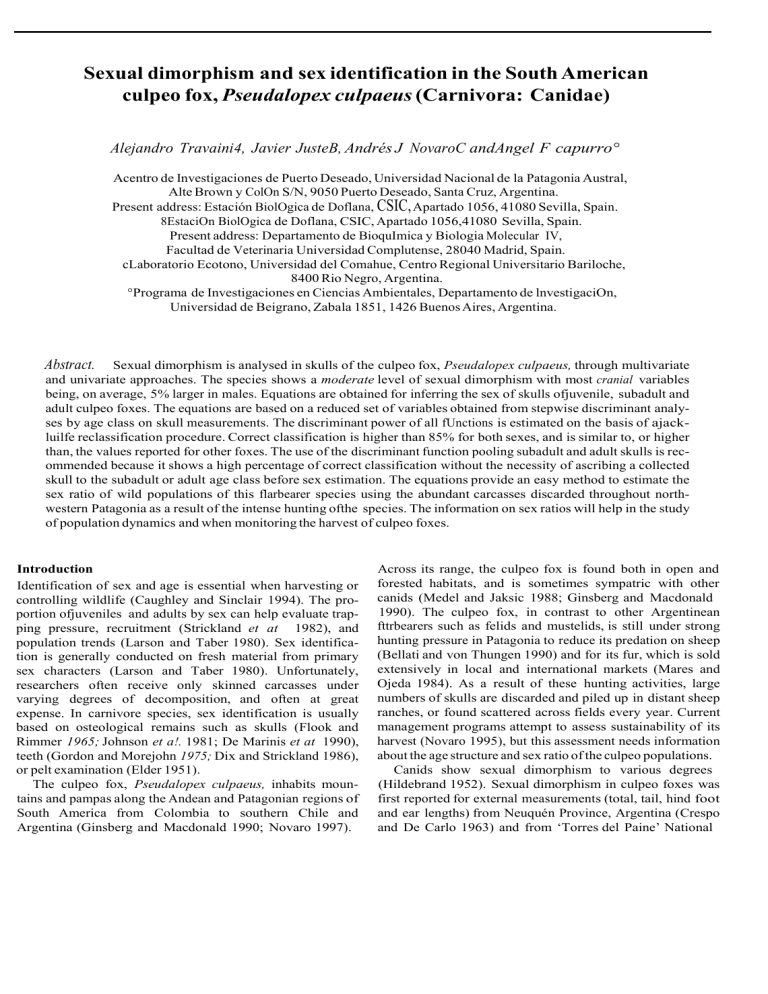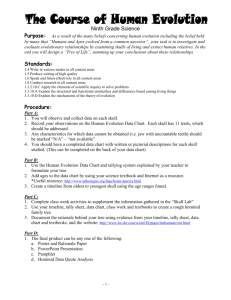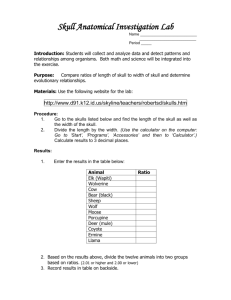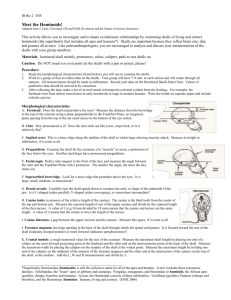wild_res_culpeo.doc

Sexual dimorphism and sex identification in the South American culpeo fox, Pseudalopex culpaeus (Carnivora: Canidae)
Alejandro Travaini4, Javier JusteB, Andrés J NovaroC andAngel F capurro°
Acentro de Investigaciones de Puerto Deseado, Universidad Nacional de la Patagonia Austral,
Alte Brown y ColOn S/N, 9050 Puerto Deseado, Santa Cruz, Argentina.
Present address: Estación BiolOgica de Doflana,
CSIC,
Apartado 1056, 41080 Sevilla, Spain.
8EstaciOn BiolOgica de Doflana, CSIC, Apartado 1056,41080 Sevilla, Spain.
Present address: Departamento de BioquImica y Biologia Molecular IV,
Facultad de Veterinaria Universidad Complutense, 28040 Madrid, Spain. cLaboratorio Ecotono, Universidad del Comahue, Centro Regional Universitario Bariloche,
8400 Rio Negro, Argentina.
°Programa de Investigaciones en Ciencias Ambientales, Departamento de lnvestigaciOn,
Universidad de Beigrano, Zabala 1851, 1426 Buenos Aires, Argentina.
Abstract.
Sexual dimorphism is analysed in skulls of the culpeo fox, Pseudalopex culpaeus, through multivariate and univariate approaches. The species shows a moderate level of sexual dimorphism with most cranial variables being, on average, 5% larger in males. Equations are obtained for inferring the sex of skulls ofjuvenile, subadult and adult culpeo foxes. The equations are based on a reduced set of variables obtained from stepwise discriminant analy ses by age class on skull measurements. The discriminant power of all fUnctions is estimated on the basis of ajack luilfe reclassification procedure. Correct classification is higher than 85% for both sexes, and is similar to, or higher than, the values reported for other foxes. The use of the discriminant function pooling subadult and adult skulls is rec ommended because it shows a high percentage of correct classification without the necessity of ascribing a collected skull to the subadult or adult age class before sex estimation. The equations provide an easy method to estimate the sex ratio of wild populations of this flarbearer species using the abundant carcasses discarded throughout north western Patagonia as a result of the intense hunting ofthe species. The information on sex ratios will help in the study of population dynamics and when monitoring the harvest of culpeo foxes.
Introduction
Identification of sex and age is essential when harvesting or controlling wildlife (Caughley and Sinclair 1994). The pro portion ofjuveniles and adults by sex can help evaluate trap ping pressure, recruitment (Strickland et at 1982), and population trends (Larson and Taber 1980). Sex identifica tion is generally conducted on fresh material from primary sex characters (Larson and Taber 1980). Unfortunately, researchers often receive only skinned carcasses under varying degrees of decomposition, and often at great expense. In carnivore species, sex identification is usually based on osteological remains such as skulls (Flook and
Rimmer 1965; Johnson et a!. 1981; De Marinis et at 1990), teeth (Gordon and Morejohn 1975; Dix and Strickland 1986), or pelt examination (Elder 1951).
The culpeo fox, Pseudalopex culpaeus, inhabits moun tains and pampas along the Andean and Patagonian regions of
South America from Colombia to southern Chile and
Argentina (Ginsberg and Macdonald 1990; Novaro 1997).
Across its range, the culpeo fox is found both in open and forested habitats, and is sometimes sympatric with other canids (Medel and Jaksic 1988; Ginsberg and Macdonald
1990). The culpeo fox, in contrast to other Argentinean fttrbearers such as felids and mustelids, is still under strong hunting pressure in Patagonia to reduce its predation on sheep
(Bellati and von Thungen 1990) and for its fur, which is sold extensively in local and international markets (Mares and
Ojeda 1984). As a result of these hunting activities, large numbers of skulls are discarded and piled up in distant sheep ranches, or found scattered across fields every year. Current management programs attempt to assess sustainability of its harvest (Novaro 1995), but this assessment needs information about the age structure and sex ratio of the culpeo populations.
Canids show sexual dimorphism to various degrees
(Hildebrand 1952). Sexual dimorphism in culpeo foxes was first reported for external measurements (total, tail, hind foot and ear lengths) from Neuquén Province, Argentina (Crespo and De Carlo 1963) and from ‘Torres del Paine’ National
Park, Chile (Johnson and Franklin 1994). Novaro (1997) reported differences in average body weights (males: 11.02 kg, n
=
11; females: 8.84 kg,
Material and Methods n
=
11) in Neuquén Province.
Nevertheless, a detailed statistical evaluation of sexual dimor phism in the culpeo fox is lacking. In fact, sexual dimorphism was neither appraised in a recent morphology-based taxo nomic revision of the group (Zunino at a!. 1995), measurements of skulls collected in the field. nor in a more general eco-morphological study on canids (Wayne dimorphism in the skull morphology of the culpeo fox, at a!.
1989). The goals of this study were to investigate sexual and to develop a simple method for sex determination based on a few
This study was based on 77 female (42 juveniles, 18 subadults and 17 adults), and 93 male (54 juveniles, 15 subadults and 24 adults) skulls of the culpeo fox trapped from 1960 to 1963 in the Catan-Lil ranch (40°S,
71°X4 780 m above sea level), Neuquén Province, north-western
Argentinean Patagonia. The skulls are deposited in the Museo Nacional de Ciencias Naturales Bernardino Rivadavia, Buenos Aires, Argentina,
The age of each specimen was determined by counting cementum annuli in thin sections of decalcified roots of the premolar teeth (Zapata at at
1997). Skulls with permanent dentition and no annuli in their teeth were considered asjuveniles; those with one cementum annulum as subadults, and those showing two or more cementum annulli as adults.
The following 16 standard cranial measurements were recorded by the senior author with a caliper to the nearest 0.01 mm total length (TL), condylobasal length (COL), basilar length (BL), palatal length (PL), dental length (DL), postorbital breadth (POB), molar breadth on M’
(MBU), zygomatic breadth (ZB), mastoid breadth (MAB), postorbital constriction (POC), condyle breadth (COB), P4 length (P4L), mandible length (MAL), mandible height (MAR), M1 length (M1L), and case height (CR). All measurements follow Wiig (1986), except for dental length (the distance from the incisor to the last molar in the maxilla), molar breadth (on M’), and case height (Fernández Vicioso and Lopez
Rebollo 1994).
Data were first inspected for normality
(PROC NOEVI of SAS). Missing values from incomplete skulls (8.78% of the original data) were esti mated using the iterative EM (expectation maximisation) method of
Little and Rubin (1987), which optimises the missing values as a set by stabilising the covariance matrix. All 16 variables were used to provide the most complete information about covariances. Differences at uni variate level were tested by one-way ATh4OVAs, and significance levels were corrected for multiple comparisons for each subset of data. Overall differences between age classes, sexes, and their interaction, were tested by a two-way multivariate analysis of variance (MANOVA). Discriminant function analysis (DFA) was used to maximise differences between groups using the pooied covariance matrix. A linear combination of the more dis criminant variables on the discriminant function (DF) was estimated by a stepwise discriminant analysis (to maximise at each step the mean
Mabalanobis distance) for the subsets of juveniles, subadults, adults, and these two last age classes pooled. Discriminating power of the flinc lions was tested by the option CR055vALIDATE of
PROC DI5CRIM of SAS, which excludes each observation being reclassified from the data set used in the calculation of the DF (SAS 1987). All analyses were carried out using Matlab ver. 4.2c.1 (The Mathworks 1994) and SAS statistical package (SAS 1987). Copies of Matlab functions written for this study are available from the authors.
Results
Males showed consistently higher values for all measure ments (except POC) and for both age classes (Appendices
1—3), having, on average, 5% larger skulls than females. The differences between sexes were all significant at the univari ate level except for the mastoid breadth (MAR) and condyle breadth (COB) in subadults, which did not reach significance after the Bonferroni ad3ustment of the P level (Table 1’). The post-orbital constriction (POC) was the most variable mea surement in all age classes (Appendices 1—3), and is known to
Table 1. Sexual dimorphism in skull measurements at the univariate level
Results of one-way ANOVAs testing for differences between sexes in culpeo skull measurements by age classes. Asterisks indicate signif icant values after a sequential Bonferroni adjustment of significance levels to a table-wise a
=
0.05 value. Acronyms for variables are defmed in Material and Methods
Variable
F
Juveniles
P if.
F
Subadults
P d.f.
F
Adults
P if.
TL
COL
BL
PL
DL
POB
MBU
ZB
MAB
POC
COB
P4L
MAL
MAR
MIL
CR
36.3
<0.001” 1,86
36.1
<0.001* 1,89
21.4
<0.001* 1,91
28.9
<0.001* 1,93
45.9
<0.001* 1,86
21.7
<0.001* 1,91
35.1
<0.001* 1,92
14.7
<0.001w
1,81
32.1
<0.001* 1,95
4.4
0.038
1.94
35.2
<0.001” 1,96
29.7
<0.001” 1,89
22.4
<0.001” 1,97
17.4
<0.001” 1,94
18.9
<0.001” 1,88
18.5
<0.001”
1,88
21.8
13.5
16.1
15.5
8.3
34.0
29.6
15.9
6.5
1.7
5.4
11.4
16.5
20.5
15.3
0.7
<0.001*
<0.001*
<0.001*
<0.001*
0.007
<0.001”‘
<0.001*
<0.001*
0.016
0.188
0.027
<0.001”
<0.001”
<0.001”
<0.001”
0.410
1,30
1,30
1,29
1,31
1,31
1,32
1,32
1,32
1,32
1,32
1,32
1,32
1,31
1,32
1,31
1,31
33.2
29.6
23.9
36.4
29.7
17.7
14.8
19.5
35.0
0.4
22.2
10.6
37.3
18.9
15.3
16.9
<0.001*
<0.001*
<0.001*
<0.001*
<0.001*
<0.001*
<0.001*
<0.001*
<0.001*
0.522
<0.001*
0.002”
<0.001*
<0.001”
<0.001”
<0.001”
1,34
1,34
1,34
1,40
1,39
1,37
1,40
1,36
1,40
1,40
1,40
1,40
1,40
1,39
1,39
1,39
decrease with age, particularly relative to other skull mea surements (Wiig 1982). In our study, this variable was the only one to show a non-significant difference between sexes in all age classes (Table 1). The POC distance accounted also for most of the variation in exploratory multivari4te analyses and was not considered in further analysis.
The MANOVA showed significant multivariate effects for sex (F
=
7.52, d.f.
=
15,152, P <
0.001), and age (F
=
6.41, d.f. 30,304, P <0.001), but not for their interaction (F 1.11, d.f. 30,304, P
=
0.32). The seven most discriminant vari ables for each function, and their coefficients, are listed in
Table 2. All DFs were highly significant (P< 0.001). The per centages of correct classifications were above 85% for all dis criminant functions and sexes. The highest values of the correct percentages were reached in the function for subadults and when data for subadults were combined with that for adults (Table 2).
Discussion
Both multivariate and univariate analyses clearly revealed sig nificant sexual dimorphism in culpeo fox skulls. The dimor phism level found (5% on average) is similar to that of the red fox, Vulpes vulpes (Travaini and Delibes 1995), and can be considered to be ‘small dimorphism’ (Ralls 1976) among car nivores. Moderate sexual dimorphism is common among canids (Hildebrand 1952; Prestrud and Nilsen 1995).
Nevertheless, this assertion may be based more on similar mor phological patterns among the species studied than on a thor ough knowledge of canids. Presumably, a small dimorphism level relates to monogamy, paternal care, and little competition for mates (Ralls 1976; Prestrud and Nilssen 1995).
The sex of any skull of the culpeo fox can be estimated by collecting skull measurements and solving the discriminant functions presented. In any of the equations a negative value will indicate that the skull is most probably that of a male. The sample used to obtain the discriminant functions can be con sidered unbiased given the wide array of capturing systems used in Patagonia, which include snares, traps, dog-chasing, poisoning and shooting (Novaro 1995). Nevertheless, pat terns of sexual dimorphism could change as a result of the known morphological variation (mainly in body size and weight) in the species across its geographic range (Fuentes and Jaksic 1979; Jimenez et al. 1995). This potential problem should be addressed before our equations are applied to culpeo fox populations in other geographic areas.
All the discriminant functions achieve a level of correct classification similar to, or higher than, those obtained for other foxes (Hell et al. 1989), mustelids (Wiig 1986; de
Marinis et al.
1990) or felids (du Toit et al. 1980; Wiig and
Andersen 1986). The variables chosen in different linear combinations in the formation of the discriminant functions reflect the general cranial length, which seems to be the main difference in skull morphology between the sexes. The equa tions for both subadults and adults included other more troph icallyrelated variables such as the length of the teeth (first lower molar and carnassial). The variable common to all the equations is the condyle breadth (COB). This variable itself was able to classify correctly around 80% of the females, but was less useful in discriminating males. According to the variables selected in the discriminant functions, sexual dimorphism seems not to be related to any particular func tional skull region in this species. The culpeo foxes differ in this characteristic from Lynx lynx (Wiig and Andersen 1986) and several mustelids (Wiig 1986), in which the trophic region of the skull is the major discriminant between sexes.
As would be expected, allometric relationships in the culpeo skulls changed differently with age between the sexes, the sexual dimorphism being greatest in the first year
(subadults). Although juveniles of the culpeo fox can reach adult body size during their first seven months (Crespo and fox by age class
For any given skull, a negative value after solving the functions indicates the most probable sex to be male. Acronyms for the vari ables are defined in Material and Methods. The entiy order in the function is shown from left to right. %F and %M show the percentages of correct classification for females and males, respectively, after ajackknife reclassification procedure (SAS 1987)
Constant
56.844
DL
—0.435
Constant FOB
122.697
—2,342
Constant TL
105.03
—1.175
Constant TL
68.352
—0.599
COB
—0.789
MBU
—1.430
COB
—1,451
Juveniles (%F
=
85.7, %M
=
85.7)
MAL
0.357
FOB
0.555
Adults (%F
=
88.2, %M
=
87.5)
BL
0.852
MBU
0.858
FL
0.430
Subadults (%F
=
100.0, %M
=
93.3)
MIL MAH
1.445
—2.779
COB
—1,233
MIL
—1.452
MIL
—2.087
Subadults
+ Adults (%F
=
91.4, %M
=
86.6)
CH
0.522
POB
—0.689
BL
0.368
BL
0.560
MAB
1.726
MAH
0.401
F4L
0.967
COL
—0.484
MAL
—0.629
DL
—0.295
COB
—0.351
De Carlo 1963), the pulp cavity of the teeth can be used to dis tinguish them by X-ray examination (Zapata et al. 1997). The basisphenoid—presphenoid suture seals up during the first year in culpeo foxes (Crespo and De Carlo 1963) and this character can be used easily in the field to distinguish subadults and adults from juveniles. Therefore, the use of the pooled equation for subadults and adults is recommended because it allows a high level of correct classifications without the necessity of ascribing a skull to the subadult or adult age class before estimation of sex.
The sex ratio in the culpeo foxes in north-western
Patagonia has shifted in the last 30 years from 0.69 females per male (Crespo and De Carlo 1965) to 0.92 females per male (Novaro 1995). This trend towards a relatively larger proportion of females has also been found in other canids under high hunting’ pressure, such as the coyote, Canis latrans (Knowlton 1972), and is interpreted as a population mechanism to cope with a high mortality rate. The shift observed in the sex ratio of the culpeo
fox could
also indicate a severe hunting pressure on the culpeo population. The equa tions presented in this study will allow managers and researchers to monitor changes in the sex ratio of culpeo foxes and thus infer population responses of the culpeo popu lation to hunting pressures.
Acknowledgments
Thanks to C. Zapata and to Matson’s laboratory (Montana,
USA) for assessing the ages of skulls and to R. E. Strauss for his statistical advice. Thanks also M. Delibes for improving earlier versions of the manuscript, to Marta Piantanida from the Museum ‘Bernardino Rivadavia’ for her kind interest and collaboration, and to Michelle Wallace for her kind revision of
English style. The ‘Federacion Argentina de Comercialización de Fauna’ provided funds to AJ.N. for assessing age of skulls at Matson’s.
References
Bellati, J., and von Thungen, J. (1990). Lamb predation in Patagonian ranches. In ‘Proceedings of 14th Vertebrate Pest Conference’. pp.263—268. (University of California: Davis.)
Caughley, 0., and Sinclair, A. R. E. (1994). ‘Wildlife Ecology and
Management.’ (Blackwell: Boston.)
Crespo, J. A., and De Carlo, J. (1963). Estudio ecolôgico de una población de zorros colorados. Revista del Museo Argentina de
CienciasNaturales ‘Bernardino Rivadavia’, EcologIa 1, 1—55.
De Marinis, A, M., Nikolov, H., and Gerasimov, S. (1990). Sex identifi cation and sexual dimorphism in the skull of the stone marten,
Martesfoina (Carnivora, Mustelidae). Hystrix 2, 35—46.
Dix, L. M., and Strickland, M. A. (1986). Sex and age determination for fisher using radiographs of canine teeth: a critique. Journal of
Wildlife Management 50,275—276.
Du Toit, S. H. C.,. vanAarde, R. J, and Steyn, A. G. W. (1980). Sex deter mination of the feral house cat Felis catus using multivariate statisti cal analyses. South African Journal of Wildlife Research 10, 82—87.
Elder, W. H. 1951. Determination of weasel sex ratios by pelt examina tion. Journal of Wildlife Management 15, 114—116.
.
Fernández Vicioso, E., and de Lopez Rebollo, F. (1994). Cranial dynam ics of the wild cat (Fells silvestris). Mammalia 58, 635—647
Flook, D. R., and Rimmer, J. (1965). Cannibalism in starving wolverines and sex identification from skulls. Canadian Field Naturalist 79,
171—173.
Fuentes, E. R., and Jaksic, F. M. (1979). Latitudinal size variation of
Chilean foxes: test of alternative hypotheses. Ecology 60,43—47.
Ginsberg, J. R., and Macdonald, D. W. (1990). ‘Foxes, Wolves, Jackals, and Dogs: An Action Plan for the Conservation of Canids.’ (IUCN:
Gland, Switzerland.)
Gordon, K. R., and Morejohn, G. V. (1975). Sexing black bear skulls using lower canine and lower molar measurements. Journal of
Wildlife Management 39,40—44.
Hell, P., Paule, L., evcenko, L. S., Danko, . Panigaj, L., and VItaz, V.
(1989). Craniometrical investigation of the red fox ( Vulpes vulpes) from the Slovak Carpathians and adjacent lowlands. Folia Zoologica
38, 139—155.
Hildebrand, M. (1952). An analysis of body proportions in the Canidae.
TheAmerican Journal ofAnatomy 90,217—256.
Jiménez, J. E., Yáfiez, J. L., Tabilo, E. L., and Jaksic, F.M. (1995). Body size of Chilean foxes: a new pattern in light of new data. Acta
Theriologica 40, 321—326.
Johnson, N. F., Brown, B. A., and Bosomworth, J. C. (1981). Age and sex characteristics of bobcat canines and their use in population assessment. Wildlife Society Bulletin 9,203—206.
Johnson, W. E., and Franklin, W. L. (1994). Spatial resource partitioning by sympatric grey fox (Dusicyon griseus) and culpeo fox (Dusicyon culpaeus) in southern Chile. Canadian Journal of Zoology 72,
1788—1793.
Knowlton, F. F. (1972). Preliminary interpretations of coyote population mechanics with some management implications. Journal of Wildlife
Management 36, 369—382.
Larson, J. S., and Taber, R. D. (1980). Criteria of sex and age. In
‘Wildlife Management Techniques Manual’. pp143—202. (The
Wildlife Society: Washhigton, DC)
Little, R. J. A., and Rubin, D. B. (1987). ‘Statistical Analysis with
Missing Data.’ (Wiley Interscience: New York.)
Mares, M. A., and Ojeda, R. A. (1984). Faunal commercialization and conservation in South America. Bioscience 34, 580—584.
The MathWorks Inc. (1994).
‘Matlab for Windows. Ver. 4.2c.’
(The
MathWorks: Massachusetts.)
Medel, R. G., and Jaksic, F.M. (1988). EcologIa de los cánidos sudamer icanos: una revision. Revista Chilena de Historia Natural 61,67—79.
Novaro, A. J. (1995). Sustainability of harvest of culpeo foxes in
Patagonia. Oryx 29, 18—22.
Novaro, A. J. (1997). Pseudalopex culpaeus. Mammalian SpeciesNo.558.
Prestrud, L., and Nilssen, K. (1995). Growth, size, and sexual dimor phism in arctic foxes. Journal ofMammalogy 76,522—530.
RaIls, K. (1976). Mammals in which females are larger than males.
Quarterly Review ofBiology 51,245—276.
SAS (1987). ‘SAS/STAT. User’s Guide. Ver. 6.’ 4th Edn. (SAS Institute:
Caiy, NC.)
Strickland, M. A., Douglas, C. W., Novak, M., and Hunziger, N. L.
(1982). Marten (Martes americana). In ‘Wild Mammals of North
America’. (Eds J. A. Chapman and GA. Feldhamer.) pp. 599—612.
(Johns Hopkins University Press: Baltimore, MD.)
Travaini, A., and Delibes, M. (1995).
Weight and external measurements of red foxes (Vulpes vulpes)
Saugetierkunde 60, 121—123. from SW Spain. Zeitschrifl für
Wayne, R. K., Valkenburgh, B. V., Kat, P. W., Fuller, T. K., Johnson, W.
E., and O’Brien, S. J. (1989). Genetic and morphological divergence among sympatric canids. Journal ofHeredily 80,447—454.
Wiig, 0. (1982). Bone resorption in the skull of Mustela vison. Acta
Theriologica 27, 358—360.
Wiig, 0. (1986). Sexual dimorphism in the skull of minks Mustela vison, Zunino, G B,, Vaccaro, 0. B., Canevari, M., and Gardner, A. L. (1995). badgers Meles meles and otters Lutra lutra. Zoological Journal of the Taxonomy of the genus Pseudalopex (Carnivora; Canidae) in
Linnean Society 87, 163—179. Argentina. Proceedings of the Biological Society of Washington 108,
Wiig, 0,, and Andersen, T. (1986). Sexual size dimorphism in skull of lynx. Acta Theriologica 31, 147—155.
729—747.
Zapata, S. C., Funes, M. C., and Novaro, A. (1997). Estimación de la edad en el zorro colorado patagonico (Pseudalopex culpaeus).
MastozoologiaNeotropical 4, 145—150.
Appendix 1. Basic statistics for skull measurements of juvenile culpeo foxes, Pseudalopex culpaeus
Acronyms for variables are defined in Material and Methods. All measurements are in millimetres. c.v.
= coefficient of variation
Distance
TL
COL
BL
PL
DL
ZB
P4L
CH
POB
MBU
POC
COB
M1L
MAH
MAB n
39
40
39
39
36
39
40
35
42
41
42
37
42
41
37
42
Mean
157.4
151.2
140.6
75,3
77.9
24.9
43.7
78.0
51.9
25.5
28.4
15.1
115.4
40.2
16.0
51.7
Females
Mm.
131.6
127.3
116.5
64.0
69.8
21.2
34.8
67.7
47.1
22.4
25.9
13.6
96.4
33.7
14.6
49.2
169.4
160.4
149.1
81.6
82.8
28.4
47.0
88.6
55.7
28,5
31.5
16.4
124.7
44.3
16.9
573 c.v.
5.2
4.5
5.3
5.0
3.7
6.9
4.8
7,1
3,9
6.5
3.5
4.0
6.1
7.4
3.4
3.3
n Mean
Males
Mm.
e.v.
51
53
53
47
54
54
55
53
48 167.6
151.0
178.0
4.5
50 160.0
143.3
170,6 4.2
53 148.2
124.7
159.5
5.4
55 79.8
67.2
86.3
5.0
82.3
74.7
87,1 3.6
26.8
23,1 30.6
7,2
46.1
41.6
50.1
4,1
54
52
51
83.0
70.5
93.3
7.1
54.4
48.7
59.2
4.1
26.4
21.2
31.3
8.5
29.7
27.6
32.7
4.0
15.9
14.3
17.5
4.9
56 122.3
99.0
133.2
6.0
42.9
16.6
53.4
35.2
13.4
50,6
49.4
18.1
58.7
7.5
4.9
3.5
Appendix 2. Basic statistics for skull measurements for subadult culpeo foxes, Pseudalopex culpaeus
Acronyms for variables are defined in Material and Methods. All measurements are in millimetres. cv.
= coefficient of variation
Variable
TL
COL
BL
PL
DL
POB
MBU
ZB
MAB
POC
COB
P4L
MAL
MAH
M1L
CH n Mean
Females
Mm.
18 168.2
159.8
176.7
3.2
18 160.6
154.2
169,1 3.3
17 150.2
143.7
158.4
3.3
17 80.3
75.6
84.3
3.2
17 82,1 78.3
86.4
3.3
18 27.3
25.8
30.1
3.7
18 45.6
43.1
48.6
2.7
18 87.5
82.3
95.3
4.0
18 54.1
51.3
57,4 3.5
18 26.4
23.5
28,9 5.5
18 28.9
27.2
30.7
3.6
18 15.3
14.5
16.6
4.0
18 124.0
117.4
131.8
3.4
18 43.3
40,0 47.8
5.1
18 16.3
15.2
17.5
3.4
18 53.9
50.3
56.4
3.5
n Mean
Males
178.3
164,9 c.v.
13 188.4
3.7
13 168.2
156.0
175.5
3.8
13 158.2
147.0
165.0
3.7
15
15
15
15
15
84,1 78.0
87.9
3.4
85.1
79.3
90.3
3.7
15
15
15
14
29,8 27.6
32.1
4,8
48.1
45.1
50.9
2.8
93.3
83.7
101.5
5.2
56,2 51.3
61.2
4.6
26.4
22.6
30.5
7.5
30.1
26.5
32.4
5.9
16.2
14.7
17.5
4.5
15 130.5
121.3
137.3
3.9
15
14
14
46.9
42.6
50.5
4.9
17.0
16,0 17.8
3.3
54.5
51.0
57.8
3.8
TL
COL
BL
PL
DL
POB
MBU
ZB
MAB
POC
COB
P4L
M1L
CH
Appendix 3. Basic statistics for skull measurements for adult culpeo foxes, Pseudalopex culpaeus
Acronyms for variables are defined in Material and Methods. All measurements are in millimetres. c.v. coefficient of variation
Variable n Mean
Females
Mm. n Mean Max. cv.
17 168.7
156.5
177.6
3.4
17 161.2
150.3
172.1
3.5
17 151.3
140.9
161.4
3.8
17 80.5
77.2
85.5
3.1
16 81.6
77.6
86.9
3.1
15 28.0
23.4
31.2
6.2
17 46.2
40.1
51.0
5,3
15 89.5
75.2
98.2
6.2
17 54.4
49.6
57.9
3.5
17 25.7
22.8
30.1
6.7
17 29.0
26.7
32.8
4.7
17 15.4
14.0
16.9
4.8
17 124.7
112.0
135.7
4.3
17 43,7 40.1
48.4
5.1
17 16.1
14.9
17.0
3.7
17 53.3
48.8
56.8
3,7
18 179.8
169.3
191.7
3.1
18 170.8
163.6
181.3
4.8
18 159.8
151.7
170.1
2.8
24
24
23
24
22
24
24
24
24
85.2
79.0
90.7
2.8
86.3
81.2
92.0
3.2
24 133.5
126.1
142.3
2.9
23
23
22
30.5
27.0
33.7
5.8
49.2
45.9
52.4
3.7
96.5
87.4
103.2
4.3
57.8
54.8
61.0
3.1
26.1
21.0
29.6
8.3
30.9
28.5
33.0
3.6
16.1
14.6
17,3 4.0
47.6
16.9
56.2
42,3
15.3
52.3
56.2
17.7
60.4
6.6
3.7
4,1




